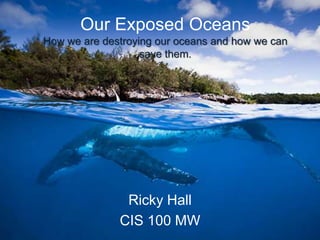
Our exposed oceans cis 100, ricky hall
- 1. Our Exposed Oceans How we are destroying our oceans and how we can save them. Ricky Hall CIS 100 MW
- 2. The Last Frontier - Oceans cover 71% of the Earth’s surface. There are over 1.75 million named terrestrial species, compared to the around 250,000 named marine species. This shows how little our knowledge of the oceans are thus far, and how much there is left to explore and learn. all donations directed towards Only 1% of environmental concerns went to ocean causes. Therefore, the issues concerning the oceans are not widely known.
- 3. Black Waters Over 217 million gallons of oil have been spilt into the ocean in the last 10 years just through oil spills , tanker spills, tanker explosions, offshore rig leaks and offshore rig blowouts. There are 600 active offshore oil rigs around the world today. Each one have “day to day” spills and leaks that account for 44 million gallons spilt in the oceans each year Oil as fuel that turns into rain pollution accounts for 144 million gallons in the ocean each year
- 4. Impact on Wildlife Large amounts of spilt oil results in large “plumes” under the surface, stretching for miles. The BP oil spill disrupted a widely used migratory area for wildlife, clogging fish’s gills, suffocating them and killing thousands of birds, fish and mammals These effect are catastrophic and the wildlife may never fully recover.
- 5. The Balancing Act A certain amount of carbon dioxide (CO2) is necessary for life on earth. However, too much can be catastrophic. 50% of CO2 is absorbed by the atmosphere, 20% by land and 30% by oceans. Before the Industrial Revolution, there was a harmonic balance. Since then, humans have added 1.5 million metric tons of C02, leaving the oceans to absorb some 500 billion tons.
- 6. Off Balance The sea absorbing the added CO2 has had many negative effects: Sea temperatures have risen at a rate of 1% annually. Meanwhile, also absorbing 80% of the heat added to the climate system. Warmer water causes volume to expand, and along with melting ice caps due to rising temperatures, its causes sea levels to rise. Global sea level is 8 inches higher than it was a century ago and continues to rise. With so much CO2, the water takes up too little oxygen, killing thousands of marine species, and leaving many dead zones in its wake. Oxygen levels in some areas have dropped as much as 20 %%
- 7. Coral Reefs Decreased PH levels in the oceans due to the intake of all this Co2 causes the water molecules to react to the carbon, increasing the oceans acidity and producing what is known as Acidification. This acid is eating away and killing coral reefs and ocean beds at alarming rates. At this continued rate, it is predicted that all coral reefs will be dead by 2030. 25% of all marine life depends directly on coral reefs. Without coral reefs the food chain would be devastated, and would threaten mass extinctions of life, from the smallest prey to the largest predators.
- 8. All Out of Fish 200 million people make a living sustainably fishing and a billion rely on oceans as their primary source of animal protein. Yet the commercial fisheries threaten that by using trawlers to unsustainably catch millions of tons of fish. 10 species account for a quarter of all fishery production. 9 out of 10 of those species are on the verge of collapse Since 1950 there has been a 90% drop in the numbers of 25 of the oceans largest predators. Scientists say seafood population could be wiped out by the second half of the century.
- 9. By-catch and Trawling Trawlers are enormous fishing nets that drag the bottom of the sea floor to net marketable fish. Bycatch are the marine animals not desired by the industry that are discarded in the process. Bottom trawlers can destroy 580 million square miles of seabed each day. Each year the worlds fleet of bottom trawlers disturb a seabed area twice the size of the US. Trawlers destroy 16lbs of marine animals for every pound marketable fish caught. Each year, out of 56.7 million tons landed, 38.5 million tons are discarded 70% of the remaining cod population have been lost to bycatch.
- 10. What We Can Do •Spread the word. •Contact your elected government officials. •Maintain your vehicle. •Donate money to environmental efforts for the ocean. •Sign petitions against offshore drilling. •Recycle. •Educate yourself about the oceans, and do your part to help protect it for future generations.
- 11. Work Cited Danson, Ted. Oceana: Our Endangered Species and What We Can Do To Save Them/Ted Danson with Michael D’Orso. Rodale Inc. 733 Third Avenue, New York, NY 10017. http://www.biologicaldiversity.org/campaigns/endangered_oce ans/index.html http://waittfoundation.org/endangered-oceans-project